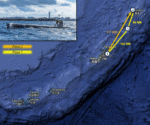General Atomics Aeronautical Systems Inc. (GA-ASI) has announced a major operational milestone: its fleet of unmanned aircraft systems (UAS) has surpassed 9 million cumulative flight hours. This achievement underscores the central role GA-ASI platforms—particularly the MQ-9 Reaper and MQ-1C Gray Eagle—play in persistent intelligence, surveillance, reconnaissance (ISR), and precision strike operations across multiple theaters.
Flight Hour Milestone Reflects Operational Maturity
The 9 million flight hour benchmark reflects over two decades of continuous UAS operations by GA-ASI platforms. According to company data and corroborated by U.S. Department of Defense sources, over 90% of these hours were logged during actual military missions. The milestone was reached in September 2025 and includes both U.S. government and international customer operations.
GA-ASI’s flagship Medium Altitude Long Endurance (MALE) platforms—the MQ-9A Reaper (used primarily by the U.S. Air Force) and the MQ-1C Gray Eagle (operated by the U.S. Army)—account for the vast majority of these hours. The company also credits newer variants like the MQ-9B SkyGuardian/SeaGuardian for contributing to recent growth in global flight activity.
This total includes both manned-unmanned teaming experiments and autonomous sorties conducted under Beyond Line-of-Sight (BLOS) control via satellite communications (SATCOM), reflecting increasing autonomy levels within GA-ASI’s ecosystem.
Platform Breakdown: MQ-9A Reaper Still Dominates
The bulk of GA-ASI’s flight hour accumulation stems from the MQ-9A Reaper fleet. Introduced into service with the USAF in 2007 as a successor to the MQ-1 Predator, the Reaper has evolved into a multi-mission platform capable of kinetic strikes, electronic warfare support, signals intelligence collection, and persistent ISR.
- MQ-9A Reaper: Over 6 million cumulative flight hours; equipped with EO/IR sensors, synthetic aperture radar (SAR), Hellfire missiles, and GBU-series bombs.
- MQ-1C Gray Eagle: Over 1 million cumulative hours; optimized for Army brigade-level ISR support with tactical datalinks and extended endurance variants like Gray Eagle ER.
- MQ-9B SkyGuardian/SeaGuardian: Increasing adoption among NATO allies; certified for integration into civilian airspace under STANAG 4671 compliance.
The company notes that its aircraft average over 60,000 operational flight hours per month globally—a figure that is likely to grow as more allied nations adopt GA platforms under Foreign Military Sales (FMS) programs.
Global Footprint Expands Through Allied Adoption
GA-ASI’s unmanned systems are now operated by more than a dozen countries including France, Italy, Spain, UK, India, Japan, Belgium and Taiwan—with Poland recently joining through its acquisition of MQ‑9A Reapers under an expedited FMS agreement signed in late 2023. The Royal Air Force operates an upgraded version known as Protector RG Mk1 based on the MQ‑9B platform.
This international footprint not only increases total flight hour accumulation but also drives interoperability within NATO-standard C4ISR architectures such as Link‑16 integration and SATCOM relay nodes. Many operators are investing in sovereign ground control stations while maintaining compatibility with U.S.-based mission planning infrastructure like GA’s Scalable Command & Control System (SC2S).
Evolving Capabilities: Autonomy & Multi-Domain Integration
The milestone coincides with GA‑ASI’s broader push toward increased autonomy and multi-domain operations. In recent years the company has demonstrated key technologies such as:
- AUTEC/MACE AI teaming trials: Human-machine teaming between crewed fighters and autonomous UAVs using artificial intelligence-enabled mission management software.
- AeroGuard autonomy stack: Enables adaptive route planning under denied GPS conditions using onboard sensors fused via AI algorithms.
- MUM-T integration: Successful tests between Gray Eagle ERs controlling smaller loitering munitions or quadrotor drones to extend sensor/shooter reach at tactical echelons.
The company is also investing heavily in resilient comms architectures using mesh networking protocols to ensure survivability against jamming or cyber disruption—a critical requirement for future contested battlespaces such as Indo-Pacific or Eastern Europe scenarios.
Sustainment & MRO Infrastructure Scales Globally
Sustaining a global fleet capable of logging millions of annual flight hours requires robust maintenance infrastructure. GA‑ASI has expanded its depot-level MRO capabilities across CONUS locations such as Poway (California), Grand Forks AFB (North Dakota), as well as forward-deployed hubs co-located with partner forces in Europe and Asia-Pacific regions.
The company also supports predictive maintenance through onboard health monitoring systems that feed into digital twin models—enabling proactive part replacement cycles rather than reactive downtime events. This approach is increasingly adopted by allied customers seeking high readiness rates without full reliance on OEM support contracts.
What Comes Next? Toward Modular Open Systems Architecture
Looking ahead to its next milestone—10 million operational hours—GA‑ASI is aligning its roadmap with DoD mandates around Modular Open Systems Architecture (MOSA). Future iterations of its UAVs will emphasize plug-and-play payload bays supporting third-party sensors or EW pods from other OEMs without requiring proprietary interfaces or software stacks.
This open architecture approach is already visible in export variants like SkyGuardian fitted with Leonardo’s SAGE ELINT system or Thales’ Searchmaster radar modules depending on customer requirements. The goal is to reduce vendor lock-in while accelerating capability upgrades across coalition fleets operating similar airframes but different mission sets—from maritime patrol to border surveillance or counter-terrorism strike packages.









